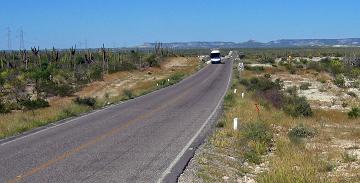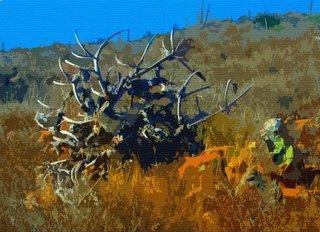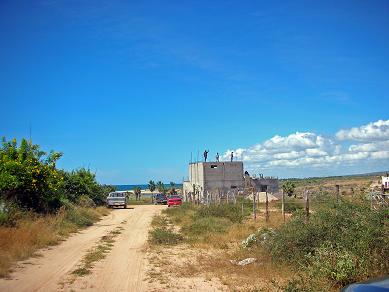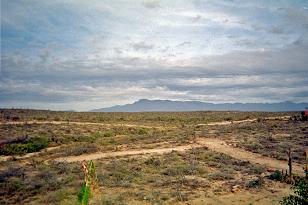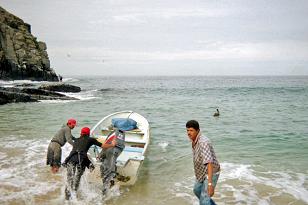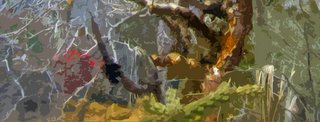Alex Brumbaugh Photo Gallery
Photo Index - Stillpoint Press Home Page
It is September 3, 2006. I am standing in the unfinished French doors of the dining room of our casita in Southern Baja looking out at the flooded arroyo. I was drawn here by a sound – an odd droning sound, as though someone in this small and isolated Gringo neighborhood had turned on a massive, pulsing generator. That would not be unusual, since we are well off the power grid.
Hurricane John passed through in the night. It may have passed over on the cape rather than through this area on the Pacific coast. I don’t know yet what its true path was because there is no phone or internet connection. I am stranded as the result of washed-out roads. All I know is what I heard in the night – howling winds and torrents of rain that left behind lakes in the dry arroyos, ruts and cave-ins in the already primitive network of dirt roads.
Sound carries far. I can hear ocean breakers way up to Punta Arielle. They sound like distant thunder. People come from all over the world to surf the waves here. I have never seen them higher than they have been the past few days.
My dog Gus stands beside me, alert, ears perked forward, peering out on the eerie new wet landscape, wondering like me at the strange new sound.
He and Susan and I crossed the border at Tijuana on July 20. We arrived in Todos Santos – 1000 miles south - on the 23rd – just six weeks ago. Like my 2-month stay here last winter, it has been so difficult to write about the experience of being in Baja.
Why is it so hard? The answer is partly because it is so raw. I feel so raw. I sit staring a lot, absorbing something primordial. Maybe that is the experience of seeing through and across ones culture into another.
Or perhaps it is the Tropic of Cancer, whose colors and light render one speechless – before, it is rumored, making one an artist.
Or - at least for this trip - it may be the often stifling and sometimes suffocating heat and humidity.
“The very air here is miraculous,” John Steinbeck wrote in 1941.* “… outlines of reality change with the moment. The sky sucks up the land and disgorges it. A dream hangs over the whole region, a brooding kind of hallucination.”
The torrents of rain water don’t flow all the way to the sea. They stop short because the dunes fronting the ocean form a barrier. So rather than a river mouth, there is now a broad lake. Water starkly defines everything in Baja, both in its abundance in the sea and gulf that envelop the peninsula, and in its scarcity inland. In Southern Baja, civilization clings tenaciously to oases. There are no cold springs that I have heard of. This time of year all natural water is warm, even these rushing creeks from the mountains. Cold tap water is tepid because it is stored in tanakas in the sun on the roof, or comes through pipes that lay in sun-baked earth. One has to ask for water in restaurants, and it comes in a bottle without ice. When the storms close the roads to Los Cabos and La Paz, the first thing to disappear from the local mercados is ice.
The strange sound seems to come from the new lake. Gus and I leave the porch, cross the fence. The path we usually take is gone, washed away in the night. As we reach the water’s edge, we see the source of the strange sound. Hurricane John has brought hundreds of thousands of frogs. The water is alive with them. Gus wades in. He senses a great feast.

The Mountains from which the waters flow are the Sierra Lagunas, forming a 5-7,000-feet-high spine down the middle of the 60-mile-wide peninsula that is Southern Baja. Highway 19 – closed today in both directions by the flooded arroyos – normally connects Todos Santos with Cabo San Lucas, 45 miles to the Southeast along the Pacific Ocean side of the peninsula. That highway turns due north from here, crossing the narrow neck of the southern peninsula to La Paz, “The City of Pearls,” on the mighty gulf that still bears the name of this country’s 16th Century conqueror: Mar de Cortez.
When it’s not closed by rain, big trucks roll constantly up and down Highway 19, hauling consumer goods from Pichilingue, the Port near La Paz, to the tourist Mecca of Los Cabos. These trucks are hand-me-down from the United States, ancient Freightliner and Peterbilt and Mack tractors pulling bent and rusting and rattling semi-trailers. Signs along Highway 19 – and along all of the paved roard of Baja - say Este camino no fue diseñado para altas velocidades. “This road was not designed for high speeds.” The speed limit is 80 KMH – about 50 MPH. The trucks average 60 – 70 MPH. The highway – often in disrepair, with big cracks and potholes - passes through open range cattle ranches. Livestock grazes near the road, often wander on to it to cross, and it is not uncommon to see bovine carcasses along the roadside, their feet extending straight up in the air, black clouds of flies hovering, buzzards eating leisurely nearby.
The road is narrower than roads in the United States, and there are no shoulders. There is often a two or three foot drop-off at the edge of the pavement. Several times I have ridden the bus from Todos Santos to Cabo San Lucas. The busses exceed the speed limit, too. It must take nerves of steel to sit on the inside seats, next to the traffic lane, where you can feel the windows shuddering when the bus passes a truck – the steel wall of the trailer a couple of inches away- going in the opposite direction.
I have never ridden the bus all the way from Tijuana to Todos Santos. The bus goes straight through, of course. A 24-hour run. I have heard that while one driver drives, the second sleeps in a little compartment underneath with the luggage.
The frogs have plenty to eat, by the way. In my view, they are more than welcome to all of it, because soon after we arrived here six weeks ago we were inundated by flies, mosquitoes, and a plethora of other bugs. They came immediately following a brief tropical storm in late July.
“Sorry for all the moscas,” apologized our dinner host and server a few weeks ago at the outdoors restaurant called Art and Beer, just south of Pescadero.
“We have heard that there are more than usual this year,” we replied, trying to enjoy our fish dinner with one hand, swatting with the other.
“After our first good storm, they will be gone,” he said.
He must have known about the frogs.
As to eating and being eaten, Gus is unsuccessful. He is unable to catch a single frog, even though the water is alive with them. All things here seem very strong - mui fuerte.
Our immediate purpose in Todos Santos has been to build a casita. We intended it to be small (“we are putting the ‘ita’ in casita,” Susan joked), but it looms larger each day. From some angles its three rooms – two down and one up – look like a palace.
When we first came, in November of 2004, we picked out the remotest lot with the best view near the then-dry arroyo in a place called (by the developer) Las Tunas. We thought doing so a unique idea. It felt as though our little spot of land was at the end of the world – or at least on the last remaining frontier. At that time one of the only other houses in Las Tunas (named for a cactus bloom) was the casita of Arturo Rivera, from whom we bought our land. I took photos from his roof when we first met him, in December of 2004.
A half mile to the north, up the rugged coast, was a horse ranch, owned (we were told) by a Hollywood starlet. Beyond that (we were led to believe) was nothing but a dirt road which, if followed 200 miles up the ocean, would connect with Baja’s Highway 1 just above a small fishing village.
As to Las Tunas itself – about three kilometers north of Todos Santos – ours and Art’s, and an odd two-story orange bungalow, and “Pierre’s House”, would be (we were allowed to believe) the only residences for years to come.
We had no suspicions that we were not unique at all, but part of a large trend.
The land had been Ejido land. Ejidos are a product of the Mexican Revolution of 1910. They are agriculture collectives owned by the Mexican people, and they have historically carried strict regulations against private (especially foreign) ownership. The 1910 Revolution (like much of Mexican history) was a bloodbath. Nearly a third of all Mexicans died in that revolution, which was intended to free the common Mexicans from foreign and capitalist influences and to restore to them their land.
A recent Mexican law allowed these Ejidos to subdivide – if all members of the collective agreed - and to sell the land to whomever they pleased.
Each time I have come here since that first visit I have been in disbelief about the number of new houses that are being built on our private frontera. First there were three new ones, then ten, then thirty. Now, new structures of concrete block and rebar emerge daily – a dreamlike medley that has become our neighborhood. The most common vehicles on the dirt road between our land and town are trucks carrying either work crews or building materials. The unemployment rate here is less than zero.
As to the wilderness to the north of us, it is not a wilderness at all. It is more Ejido land, large scale agriculture, settlements with families and children who ride to school in Todos Santos on yellow busses. These Ejidos have not yet voted to sell their land. When they do, these families will get a lot of money, and will buy new 4-wheel-drive Fords and Toyotas and Jeeps, and they will have – momentarily at least - plenty to eat.
I have a fantasy about Antonio, one of the men working on building our casita. He is the only worker who speaks any English. The reason is that he works other seasons and other hours as a chef, and his experience in the high-end gringo-serving restaurant business has made learning English an asset for him. My fantasy is that one day he will come over to me and ask why I am here. Why have I left the Colossus of the North where the streets are paved with gold and where everything works to come to his country, where it is hot and dusty and dry and poor?
Just South of Todos Santos off Highway 19 there is a dirt road turn-off.
Leading off to the right, toward the ocean, is Punta Lobos,
the place where fishermen launch their Pangas – large
outboard motor boats. There is no harbor near here, no piers or docks,
so the fishermen push the boats into the dangerous surf and then jump
in. Susan and I went there once when we first came in July to watch
them return in the afternoon from their day’s fishing. As they
approach shore, they circle, 50 yards out, watching the steep and powerful
waves, biding their time, waiting for the right surf-break. And then,
here they come, the big roaring outboard motor wide open, hitting the
kill switch and hauling up the rudder the second the nose of the Panga
hits the sand.
They cleaned and butchered a perch for us on the spot. We took it home and fried it. It was old and tough.
In the morning Gus and I return to the lake. I have my camera, eager
to photograph frogs. But they are all gone. They had seemed to arrive
not by way of the streams, but out of the earth itself. It turned out
that this was true. These were that variety of desert frog that spends
most of their lives burrowed deep in the desert soil in a cocooned,
dormant state. When it rains, they emerge. When the rain stops, they
return to the earth.
The license plates in Baja say “frontera.” I think that’s the common myth people have about Baja – that it is a real frontier. By frontier is sometimes implied a harshness and a ruggedness; in this regard, Baja is at the least not a land of abundance. What wealth there is is scratched out. There is great beauty here, but it is rugged and desolate beauty.
The soul forever longs for new frontiers, yearns to be off the grid, unplugged from the paradigm of civilization. It is like nectar, like bathing naked in a warm mountain stream.
* The Log From the Sea of Cortez, 1941. Penguin Books 1977 Edition p 94.
%2018%20x%2011.jpg)
%20-%20Baja%20California%20Sur%20between%20Todos%20Santos%20and%20Rancho%20Nuevo%20-%20Size%208%20x%2010.jpg)
